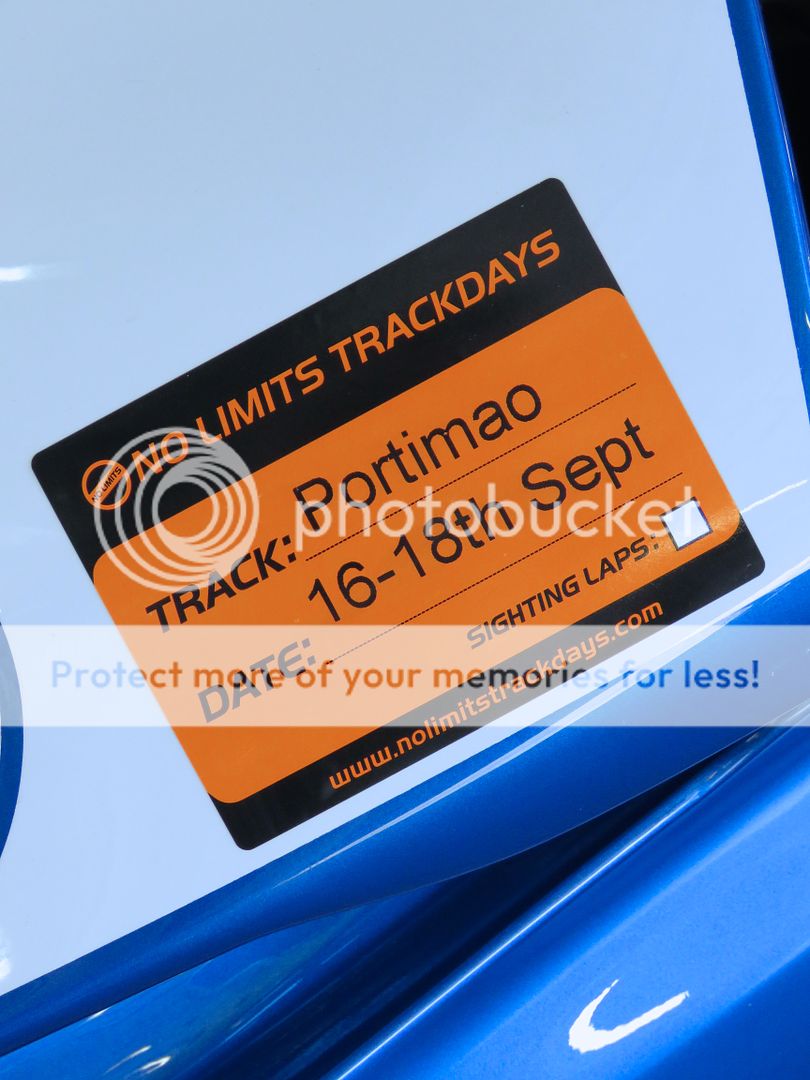You are using an out of date browser. It may not display this or other websites correctly.
You should upgrade or use an alternative browser.
You should upgrade or use an alternative browser.
BMW S1000RR Sport
- Thread starter fast_ryan
- Start date

Help Support S1000RR FORUM:
This site may earn a commission from merchant affiliate
links, including eBay, Amazon, and others.
fast_ryan
Well-known member
- Joined
- Apr 1, 2015
- Messages
- 4,696
- Reaction score
- 18
European Trackday
No Limits use Hathaways Haulage to ship the bikes to their European track events. They provide the stillage but you have to supply the ratchet straps to secure the bike and film wrap. As for kit I've taken spare wheels, several sets of Metzeler race tyres, a basic toolkit, paddock stands and tyre warmers. I've also managed to pack my race leathers and helmet so that everything will be waiting for me in pit lane when I arrive next week.
Jesus that's a lot of gear. Did you supply the wrap or do they?
No Limits use Hathaways Haulage to ship the bikes to their European track events. They provide the stillage but you have to supply the ratchet straps to secure the bike and film wrap. As for kit I've taken spare wheels, several sets of Metzeler race tyres, a basic toolkit, paddock stands and tyre warmers. I've also managed to pack my race leathers and helmet so that everything will be waiting for me in pit lane when I arrive next week.
fast_ryan
Well-known member
- Joined
- Apr 1, 2015
- Messages
- 4,696
- Reaction score
- 18
European Trackday
My bike is being shipped to Portim?o, Portugal. This time of year it can be a bit damp first thing in the morning so I've packed wets just in case. I probably won't need them as the forecast is stating temperatures of 33?C for most of next week.
Taking wets to spain? I use wet days as beer days. Never taken wets never will. Have a great trip. My bike gets shrink wrapped in 2 weeks for aragon
My bike is being shipped to Portim?o, Portugal. This time of year it can be a bit damp first thing in the morning so I've packed wets just in case. I probably won't need them as the forecast is stating temperatures of 33?C for most of next week.
Good luck  enjoy weather and cold beer
enjoy weather and cold beer 

$143.96
$177.66
Cardo Spirit HD Motorcycle Bluetooth Communication Headset - Black, Single Pack
Amazon.com

$29.99
For S1000RR S1000R HP4 Tank Pad 5D Real Carbon Fiber Motorcycle Fuel Tank Pad Kit Pad Motorcycle Decal Vinyl Tank Protector
xiangyang(shenzhen)maoyiyouxiangongsi
fast_ryan
Well-known member
- Joined
- Apr 1, 2015
- Messages
- 4,696
- Reaction score
- 18
Portim?o (Part1)
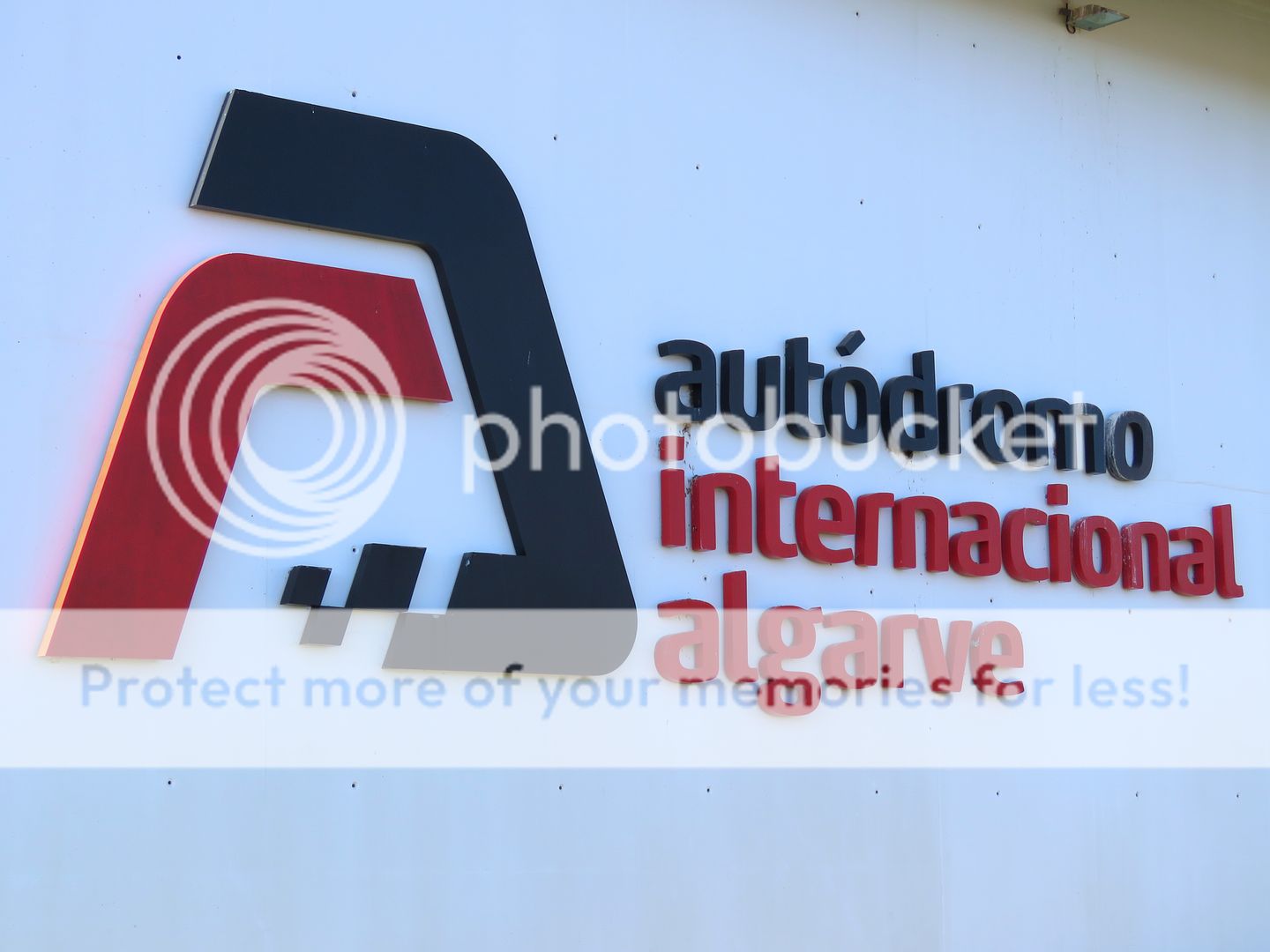
Last season I had planned on doing a couple of European trackdays onboard my S1000RR but the opportunity never presented itself. This year however I made a point of booking three full days on track at the Portim?o (Aut?dromo Internacional Algarve) circuit in Portugal. The UK is fortunate enough to have some of the best circuits in the world but there are countless more across Europe which feature on the WSBK and MotoGP race calendars that are all reasonably accessible.
When you first arrive the track is fairly daunting with its towering grandstands and the circuit itself commands respect as its like no other. The circuit layout has been described as being like a high-speed roller coaster and no recorded onboard lap does the undulation and elevation changes justice. It's also a relatively new international level circuit which means that there are plenty of run-off areas, it's safe and the facilities are state of the art.
The track is immensely challenging but once you identify where the blind crests and tricky cambers are you can really just go for it. It's also a physically demanding circuit with nowhere to relax on the bike. You would think that the long start/finish straight would offer some respite but it doesn't as there is a crest on that to and as you?re travelling so fast out of the final turn, it?s no time at all before you?re on the brakes for turn one. Epic is a word I rarely use but this track really is.
I made a point on both Day 1 and 2 to spend one session with an instructor as the circuit is quite difficult to learn given the sheer number of blind crests, corner entries and apexes. This is the first track that I've ever been too where there isn't a single corner which I dislike. Yes, they vary in difficulty but every one is enjoyable for different reasons.
The start/finish straight is the longest time you stay upright on the bike and every lap will see 180+ mph displayed on the clocks before plunging downwards towards the first corner. This first section is fast and hard to perfect as there is only a thinly painted kerb that separates the track from the tarmac run-off.
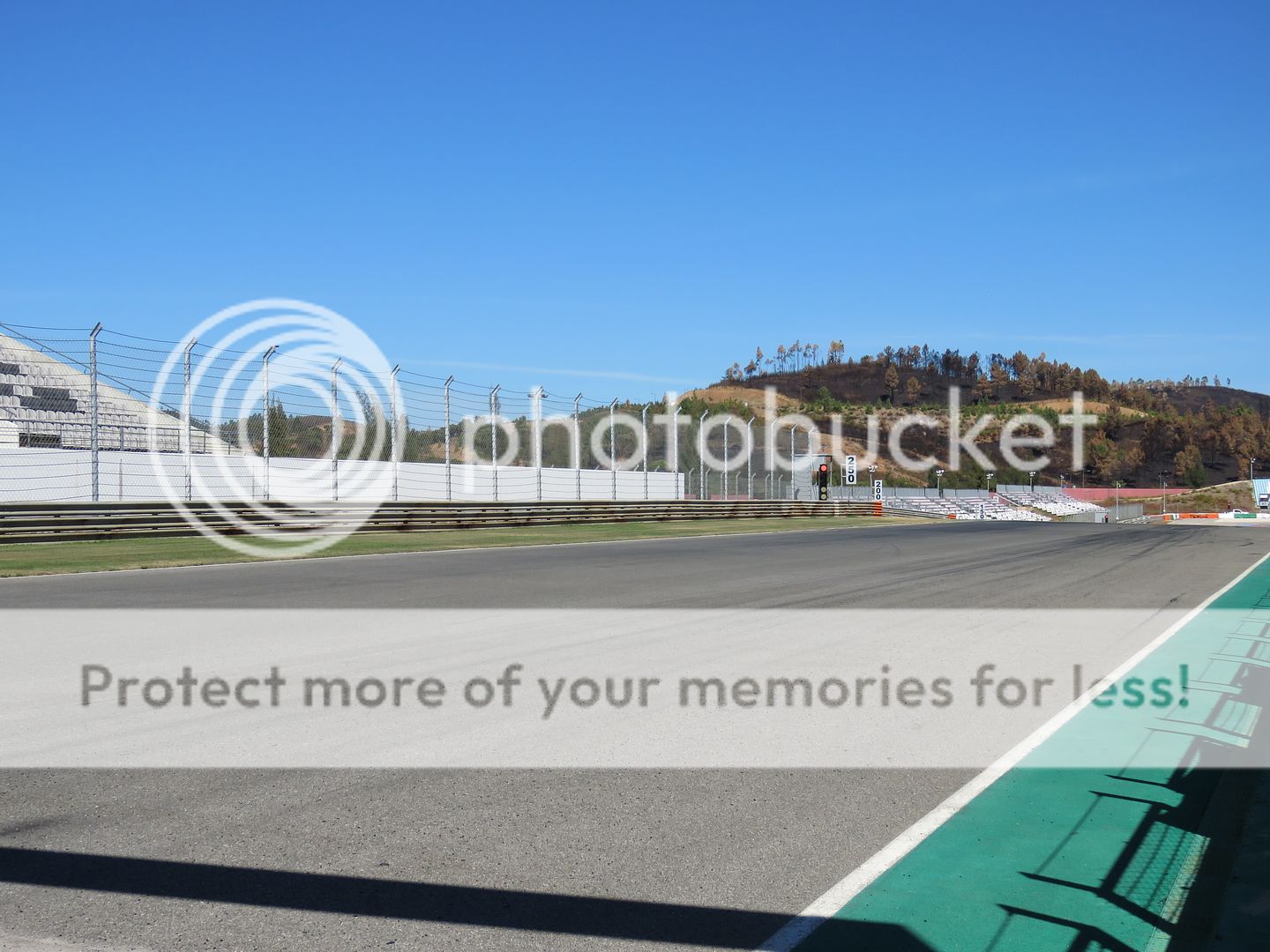
Entry into Turn 1 is on par with that of Paddock Hill bend at Brands Hatch such is the steepness. Braking hard and changing down from 6th to 3rd gear getting on the correct line is essential as it allows you to use all of the track and sweep into Turn 2. A well setup front end is needed to have the confidence to carry speed through the corner. That said if you scrub off too much speed on entry you then compromise your line going through Turn 2 as both corners are quite similar.
Turn 3 is the slowest part of the entire circuit and braking is made more difficult by virtue that you are not fullly upright. It's made more complicated as you are trail braking all the way to the apex and loading the front tyre. A nice wide entry into the hairpin will keep you mid-track on the exit enabling you to set yourself up for the rise up through the next left. It's incredibly important not to run too wide on the exit so you need to physically muscle the bike around the inside curb. Failure to do so will mean that you sacrifice track placement for entry into the next corner. I then short shifted upto third gear for Turn 4 as changing mid-corner, even in race shift, is difficult when lent over and accelerating. This uphill left corner is tremendous but the corner exit is completely blind and its also extremely easy to turn in too soon. If you get it right and use all of the track, including the painted curbing, you can then accelerate hard through to 4th gear testing rear tyre grip and up the short straight and over another crest. Here I found I also had to increase the resistance of the steering damper to settle things down despite having it on the track setting recommended in the Owner's Manual.
Turn 5 is a downhill left hand hairpin, best taken in 2nd gear, and is an incredibly difficult corner to get right. Corner entry is downhill and the tarmac braking area is rippled with bumps which tests front tyre stability. Fortunately there is a huge area of run-off for when you inevitably get it wrong and have to stand the bike up. I found down shifting early here beneficial as I found using the engine braking helped me get to the apex. Once you've avoided losing the front end you then need to guide the bike around the inside of the curb as tight as you can. You then use all of the track on exit using the quickshifter at full throttle changing up to third gear and watching the DTC light flash as you accelerate back uphill for yet another elevation change.
Turn 6 is another blind entry and taken whilst accelerating before aiming for a braking point that you can't even see until you are on it. You can then set yourself up for Turn 7 which can be taken much quicker than you originally think and carry considerable corner speed through the apex.
Slow in is an absolute must for Turn 8 as you get yourself and the bike set up for the sheer drop-off which follows immediately after corner exit. Running wide isn't really an option but I found short shifting up to fourth gear, getting my weight forward, along with the BMW anti-wheelie system, helped immensely in controlling the rate at which the front comes up as you accelerate hard over the brow of the hill. This part of the track is absolutely sensational and there is nothing else quite like it. The view down the hill primes you for what comes next.
Whilst you are trying to keep the front down and dropping down the hill you are also trying to get to the right hand side of the circuit. This allows you to use all the track so you can then sweep back uphill into Turn 9. Huge lean angle is produced here as you clip the left apex in third gear at around 100 mph.
On the circuit map Turn 10 and 11 appear as two separate corners but you have to almost treat them as one. Getting Turn 10 wrong invariably ruins your entry into Turn 11. Not quite a double right hand corner but the corner entry of Turn 10 is completely blind and easy to overshoot as you arc around to turn into Turn 11 and fire yourself downhill. There are a few bumps at the apex so a well setup bike is essential to avoid upsetting the suspension too much. This section took me lap after lap to get right as there are no obvious reference points. If your track position is correct coming out of Turn 11 you can take Turn 12 at full throttle but only if on the right line. I had to increase the height of my rearsets slightly for extra ground clearance through this corner as the speed and lean angle you carry through it is phenomenal.
The entry into Turn 13 is particularly difficult, and like Turn 3, is quite slow. Both braking and turn-in is made harder simply as all you can see on the approach is blue sky and the very top of the marshall's post. I found a useful marker on the circuit was to aim for the left hand leading edge of a new patch of tarmac which once spotted allowed me to have a wide entry and hit a late apex so I could be mid-track on the exit. The corner starts off quite tight and then opens up as you get on the throttle and accelerate out of the corner before clicking up into 3rd gear.
Using all of the circuit on entry, Turn 14 is an incredibly fast right hand bend. The camber drops off initially but comes back to you as you navigate through the corner. If you get on the wrong line throughout the corner there is a particularly nasty bump which unsettles the suspension on the exit. If you get it right you can then fire yourself towards the final corner accelerating up to 4th gear for the entry into Turn 15.
Turn 15, the final corner, and is a breathtaking downhill right hander taken in 4th gear. It is easy to get sucked in carrying too much speed as you risk losing the front end on the blind crest mid-corner. As soon as you drop down over the brow you can then accelerate as hard as possible aided by the positive camber. From here it's just a case of accelerating hard and as soon as you crest the rise at the start of the start/finish straight, and in go between the grandstands, you can then work up to 6th gear and keep the throttle pinned to complete the lap.
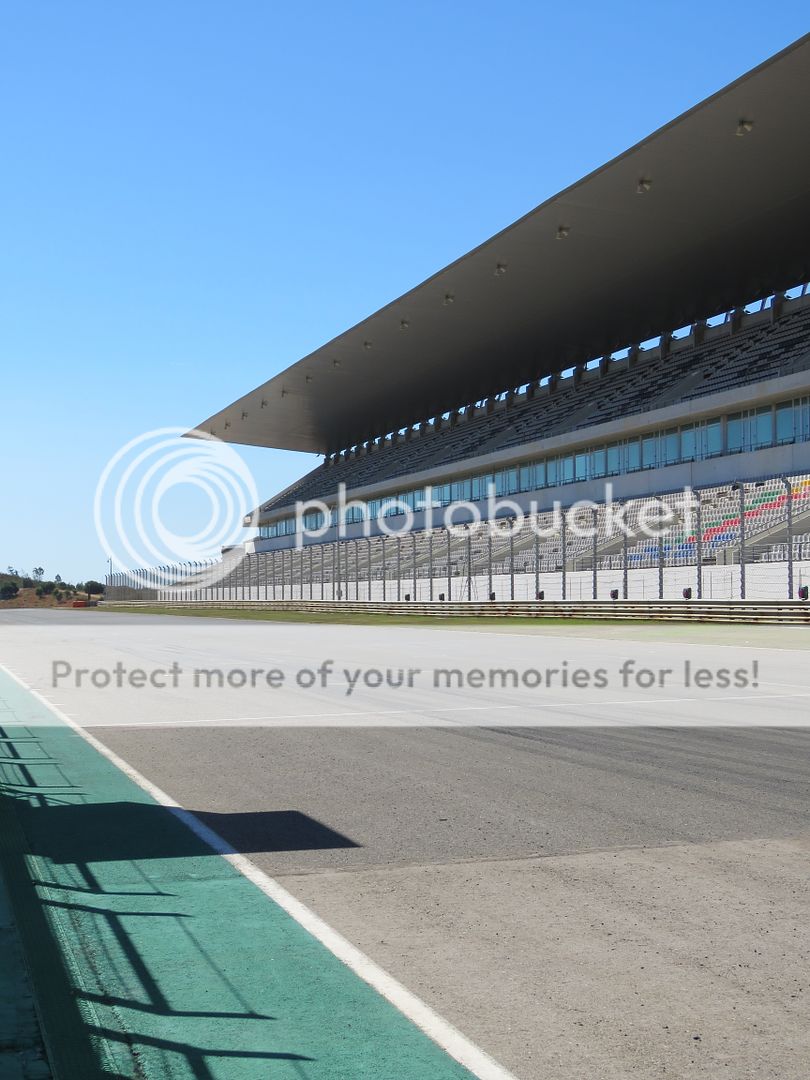

Last season I had planned on doing a couple of European trackdays onboard my S1000RR but the opportunity never presented itself. This year however I made a point of booking three full days on track at the Portim?o (Aut?dromo Internacional Algarve) circuit in Portugal. The UK is fortunate enough to have some of the best circuits in the world but there are countless more across Europe which feature on the WSBK and MotoGP race calendars that are all reasonably accessible.
When you first arrive the track is fairly daunting with its towering grandstands and the circuit itself commands respect as its like no other. The circuit layout has been described as being like a high-speed roller coaster and no recorded onboard lap does the undulation and elevation changes justice. It's also a relatively new international level circuit which means that there are plenty of run-off areas, it's safe and the facilities are state of the art.
The track is immensely challenging but once you identify where the blind crests and tricky cambers are you can really just go for it. It's also a physically demanding circuit with nowhere to relax on the bike. You would think that the long start/finish straight would offer some respite but it doesn't as there is a crest on that to and as you?re travelling so fast out of the final turn, it?s no time at all before you?re on the brakes for turn one. Epic is a word I rarely use but this track really is.
I made a point on both Day 1 and 2 to spend one session with an instructor as the circuit is quite difficult to learn given the sheer number of blind crests, corner entries and apexes. This is the first track that I've ever been too where there isn't a single corner which I dislike. Yes, they vary in difficulty but every one is enjoyable for different reasons.
The start/finish straight is the longest time you stay upright on the bike and every lap will see 180+ mph displayed on the clocks before plunging downwards towards the first corner. This first section is fast and hard to perfect as there is only a thinly painted kerb that separates the track from the tarmac run-off.

Entry into Turn 1 is on par with that of Paddock Hill bend at Brands Hatch such is the steepness. Braking hard and changing down from 6th to 3rd gear getting on the correct line is essential as it allows you to use all of the track and sweep into Turn 2. A well setup front end is needed to have the confidence to carry speed through the corner. That said if you scrub off too much speed on entry you then compromise your line going through Turn 2 as both corners are quite similar.
Turn 3 is the slowest part of the entire circuit and braking is made more difficult by virtue that you are not fullly upright. It's made more complicated as you are trail braking all the way to the apex and loading the front tyre. A nice wide entry into the hairpin will keep you mid-track on the exit enabling you to set yourself up for the rise up through the next left. It's incredibly important not to run too wide on the exit so you need to physically muscle the bike around the inside curb. Failure to do so will mean that you sacrifice track placement for entry into the next corner. I then short shifted upto third gear for Turn 4 as changing mid-corner, even in race shift, is difficult when lent over and accelerating. This uphill left corner is tremendous but the corner exit is completely blind and its also extremely easy to turn in too soon. If you get it right and use all of the track, including the painted curbing, you can then accelerate hard through to 4th gear testing rear tyre grip and up the short straight and over another crest. Here I found I also had to increase the resistance of the steering damper to settle things down despite having it on the track setting recommended in the Owner's Manual.
Turn 5 is a downhill left hand hairpin, best taken in 2nd gear, and is an incredibly difficult corner to get right. Corner entry is downhill and the tarmac braking area is rippled with bumps which tests front tyre stability. Fortunately there is a huge area of run-off for when you inevitably get it wrong and have to stand the bike up. I found down shifting early here beneficial as I found using the engine braking helped me get to the apex. Once you've avoided losing the front end you then need to guide the bike around the inside of the curb as tight as you can. You then use all of the track on exit using the quickshifter at full throttle changing up to third gear and watching the DTC light flash as you accelerate back uphill for yet another elevation change.
Turn 6 is another blind entry and taken whilst accelerating before aiming for a braking point that you can't even see until you are on it. You can then set yourself up for Turn 7 which can be taken much quicker than you originally think and carry considerable corner speed through the apex.
Slow in is an absolute must for Turn 8 as you get yourself and the bike set up for the sheer drop-off which follows immediately after corner exit. Running wide isn't really an option but I found short shifting up to fourth gear, getting my weight forward, along with the BMW anti-wheelie system, helped immensely in controlling the rate at which the front comes up as you accelerate hard over the brow of the hill. This part of the track is absolutely sensational and there is nothing else quite like it. The view down the hill primes you for what comes next.
Whilst you are trying to keep the front down and dropping down the hill you are also trying to get to the right hand side of the circuit. This allows you to use all the track so you can then sweep back uphill into Turn 9. Huge lean angle is produced here as you clip the left apex in third gear at around 100 mph.
On the circuit map Turn 10 and 11 appear as two separate corners but you have to almost treat them as one. Getting Turn 10 wrong invariably ruins your entry into Turn 11. Not quite a double right hand corner but the corner entry of Turn 10 is completely blind and easy to overshoot as you arc around to turn into Turn 11 and fire yourself downhill. There are a few bumps at the apex so a well setup bike is essential to avoid upsetting the suspension too much. This section took me lap after lap to get right as there are no obvious reference points. If your track position is correct coming out of Turn 11 you can take Turn 12 at full throttle but only if on the right line. I had to increase the height of my rearsets slightly for extra ground clearance through this corner as the speed and lean angle you carry through it is phenomenal.
The entry into Turn 13 is particularly difficult, and like Turn 3, is quite slow. Both braking and turn-in is made harder simply as all you can see on the approach is blue sky and the very top of the marshall's post. I found a useful marker on the circuit was to aim for the left hand leading edge of a new patch of tarmac which once spotted allowed me to have a wide entry and hit a late apex so I could be mid-track on the exit. The corner starts off quite tight and then opens up as you get on the throttle and accelerate out of the corner before clicking up into 3rd gear.
Using all of the circuit on entry, Turn 14 is an incredibly fast right hand bend. The camber drops off initially but comes back to you as you navigate through the corner. If you get on the wrong line throughout the corner there is a particularly nasty bump which unsettles the suspension on the exit. If you get it right you can then fire yourself towards the final corner accelerating up to 4th gear for the entry into Turn 15.
Turn 15, the final corner, and is a breathtaking downhill right hander taken in 4th gear. It is easy to get sucked in carrying too much speed as you risk losing the front end on the blind crest mid-corner. As soon as you drop down over the brow you can then accelerate as hard as possible aided by the positive camber. From here it's just a case of accelerating hard and as soon as you crest the rise at the start of the start/finish straight, and in go between the grandstands, you can then work up to 6th gear and keep the throttle pinned to complete the lap.

fast_ryan
Well-known member
- Joined
- Apr 1, 2015
- Messages
- 4,696
- Reaction score
- 18
Portim?o (Part 2)
I don't normally look at the data captured during a trackday until after the event but given I had three full days at the circuit it made sense to review it each night to make the most of my time on track the next day.
To make sense of all the graphs, you have to sort through a large amount of data, starting with the basics: throttle position, speed, braking points and lean angles. Because the system is tied in with GPS data, you can easily see each input and data stream as it relates to a specific corner on track. By comparing laps, you can immediately see where and how your inputs contributed to a faster lap. For example, you?ll quickly see where you are getting on the brakes too early, or applying the throttle too late, or too slowly.
From there, you can then determine if the traction control is helping your lap times or hurting them. By examining how and where the DTC is intervening and comparing it to data such as wheel speeds and lean angle, you can then see where the DTC system is working to prevent slides. You can then compare it to a segment where a change in riding technique could put more power to the ground instead of wasting energy by spinning up the rear tyre. You can also see, thanks again to the GPS overlay how changes in racing lines affect the usage of DTC directly. Learning these relationships does take time as you have to experiment with the 2D software. I'm still learning despite having the HP Race Datalogger fitted to my bike since May 2015.
The GPS circuit overlay is also hugely useful in working on consistent lap times, especially as Portim?o has some quite difficult and immensely fast corners. It is also a very undulating circuit with many blind crests and corner entries. Comparing various laps on screen, and looking at GPS traces of each, allows you to quickly understand where you are making progress. In contrast it also allows to you to see where you are making mistakes and costing losing time. Where it really helped around Portim?o was in Turn 12 as after analysing the data, and considering where the bike was on the track I could quickly determine that if I altered my line and push further right across the track I could go through the corner flat out as opposed to backing off the throttle. I also struggled with Turn 15 on the first day and I couldn't quite work out why. Looking at the data helped as I was frequently triggering the DTC and when looking at the spikes in traction control intervention and the rapid increase in slip rate it was abundantly clear that I was asking for way too much power, causing significant tyre slip over the bumps. I backed off the throttle during Day 2 and adopted a slow in, fast out approach and as soon as I was over the crest I could then feed in the throttle as hard as possible to get good drive onto the start/finish straight.
Compared to simply riding around guessing where I could improve the datalogging certainly helped me quantitatively improve each day and get more from my time on track. The progression in best lap times over the three days clearly illustrate this. That said whilst my times are reasonably quick, for perspective, the quickest time at the official WSBK test last year was an unbelievable 1:42.34.
Best lap time on Day 1 - 2:05.89
Best lap time on Day 2 - 2:01.42
Best lap time on Day 3 - 1:59.88
Whilst datalogging is a great tool for helping you go quicker my reduction in lap times can also be directly attributed to following the instructors around the track for a full session each day. Circuit knowledge is absolutely key to a good lap time around Portim?o and sometimes you just can't beat a bit of one-to-one coaching and feedback.
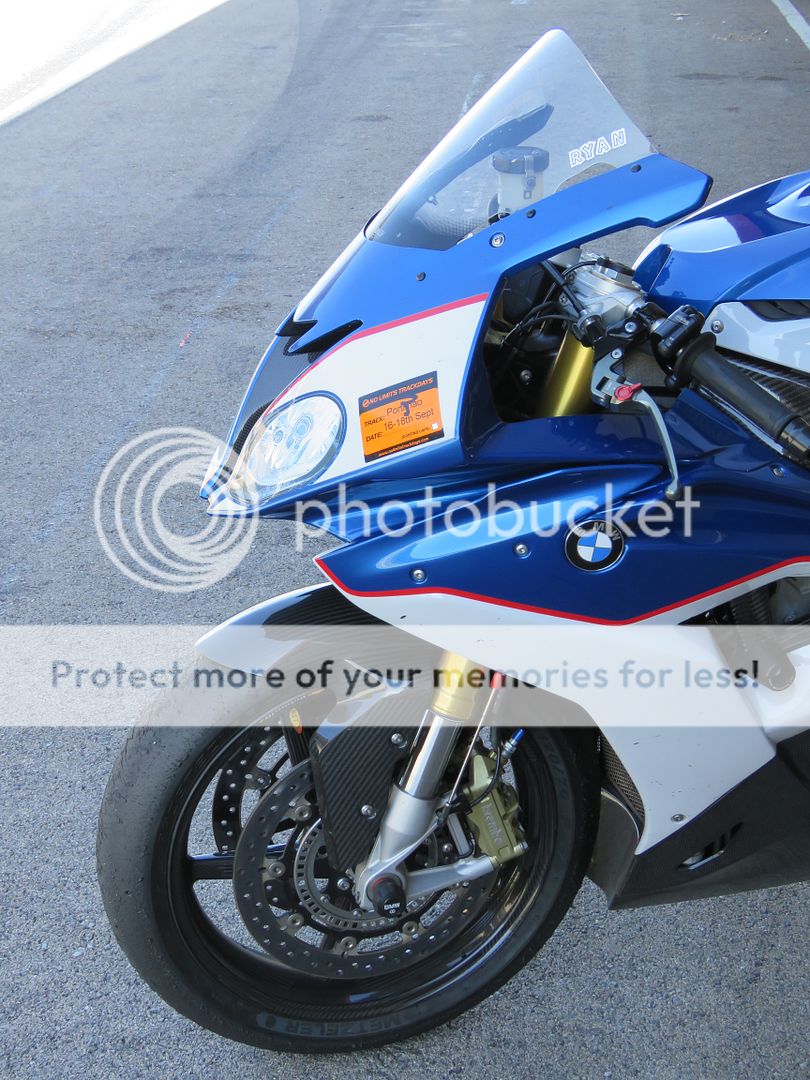
I normally just use superstock race tyres on track and don't generally bother with slicks but for the three days at Portim?o I thought I would treat the BMW to some. I took a couple of sets of Metzeler Racetec RR slicks with out with me including K1 (Soft) and K2 (Medium) compound fronts and K1 and K2 compound rears.
Having been massively impressed with the treaded Racetec RRs this season the slick variant of the Racetec RRs is quite simply outstanding. The grip offered by the treaded version is excellent but these are fantastic. If you were thinking these were just the same tyres but without the grooves cut into the surface you couldn't be further from the truth. Whilst they feel similar, they are in fact completely different and offer even more grip and feel through the bars. The rear profile is also different to the superstock RR tyres as it has a slightly taller 60 height which helps the bike turn in quicker.
Weather conditions throughout were dry and sunny with temperatures over the three days varying between 30-33?C and track temperature peaking at 48?C. Furthermore the track surface is not as abrasive as I first thought. Tyre pressure ranges are identical to the RR version and I settled on 32F and 26R hot pressures which seemed to cope well with the temperature and surface.
I started off using a K1 front and a K2 rear as that is what I had fitted prior to the bike leaving the UK. After a day and a half both front and rear needed to be changed. Whilst wear was consistent across the entire profile of the tyre the wear markers had completely disappeared.
I then changed tyres and reversed the compound combination to a K2 front and K1 rear. Looking at the Metzeler data sheets, and after discussion with the tyre fitter, this combination was definitely more appropriate for the hot conditions. The K2 front has a stronger sidewall wall and is less susceptible to high track temperatures than the softer K1 tyre. You can feel the difference on track as the front just feels more composed especially under heavy braking due to the firmer construction. With regards to the softer rear tyre, grip felt similar but tyre wear was marginally better. I would certainly use this combination again in hot conditions but revert back to a K1 front and K2 rear for colder UK trackdays. After completing seven full sessions each day, equating to well over 400 miles on track, I would certainly use the Racetec RR slicks again.
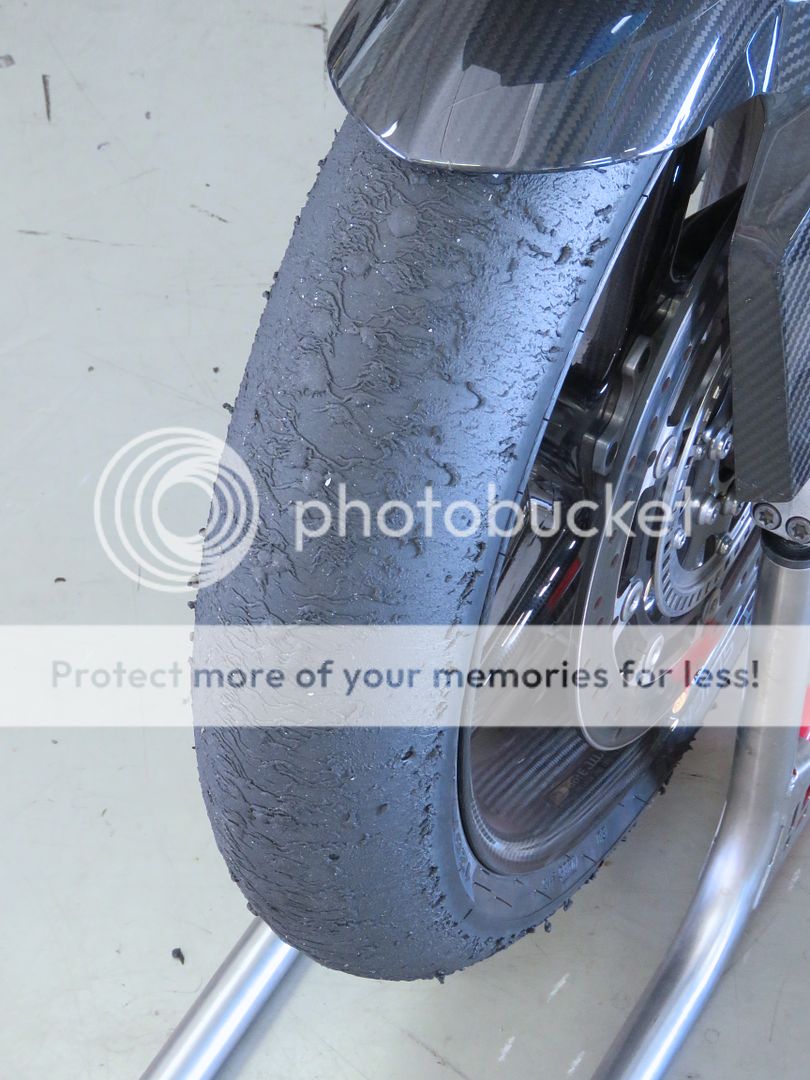
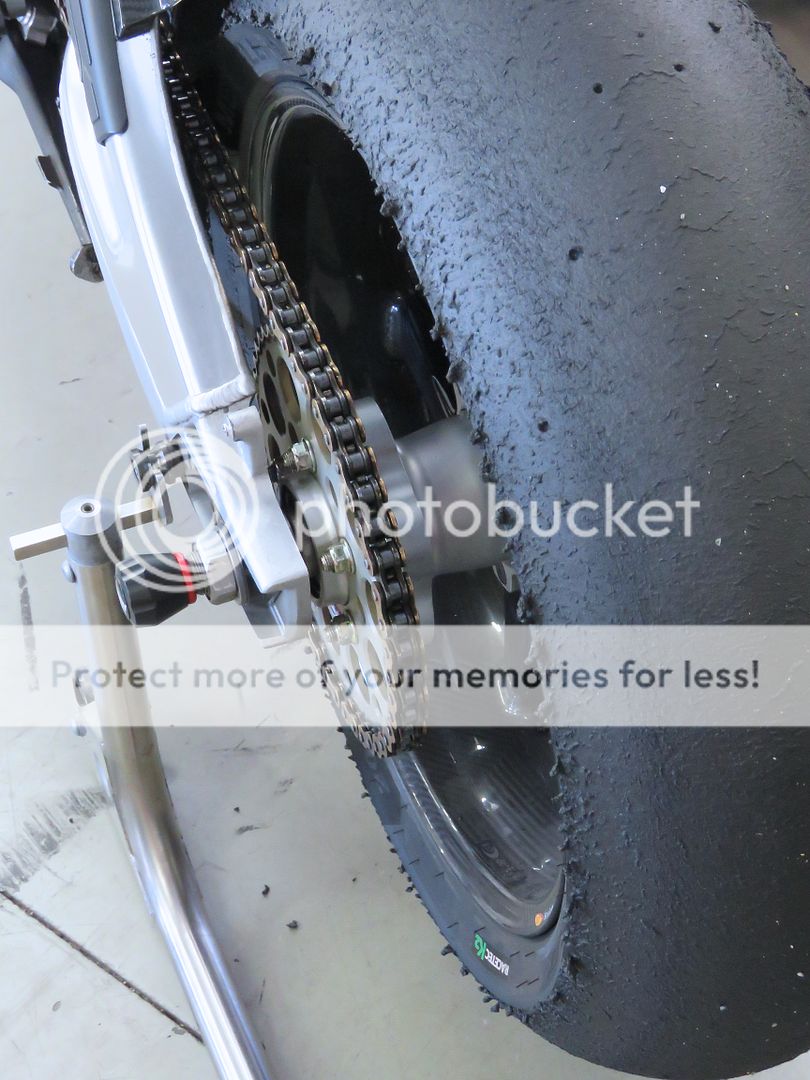
With regards to rider aids and electronics I started off Day 1 in RACE mode as I was learning the circuit but by the end of the first day I then reverted back to SLICK mode. My settings are a little different to the standard riding modes as I have the HP racing data release and mapping installed within the ECU. This makes RACE mode a lot more aggressive and SLICK mode even more so than standard. By the middle of Day 2 I had placed the bike in USER mode with all options in SLICK except the engine which I placed in RACE. I found the extra engine braking really helped slow the bike allowing me to get off the brakes earlier in order to settle the suspension, especially over the bumps, before entering the faster corners. Other than that I didn't really feel the need to experiment with the electronic settings within USER mode any further.
Portim?o really does illustrate just how good the onboard electronics and DTC actually are. You know the DTC is working as you see a flashing orange light on the dash but it doesn't feel intrusive especially when you start selecting negative values. There were also no issues with the DTC despite having a taller 200/60 rear profile tyre fitted which has a very different centre diameter to the 55 tyre. For reference I've now used 200/55, 200/60 and 190/60 race tyres without issue.
Finally, the only suspension change made was a very small adjustment to rear preload to take into account the taller profile of the 200/60 K2 Metzeler Racetec RR slick. Other than that there was very little to be gained from adjusting front/rear rebound or compression as tyre wear looked fine and the bike wasn't preventing me from holding a line or doing anything untoward which required adjustment.
Overall this has got to be simply the best track event I've done in years and I'm already planning to return to Portim?o next season along with a visit to another European MotoGP or WSBK circuit.
I don't normally look at the data captured during a trackday until after the event but given I had three full days at the circuit it made sense to review it each night to make the most of my time on track the next day.
To make sense of all the graphs, you have to sort through a large amount of data, starting with the basics: throttle position, speed, braking points and lean angles. Because the system is tied in with GPS data, you can easily see each input and data stream as it relates to a specific corner on track. By comparing laps, you can immediately see where and how your inputs contributed to a faster lap. For example, you?ll quickly see where you are getting on the brakes too early, or applying the throttle too late, or too slowly.
From there, you can then determine if the traction control is helping your lap times or hurting them. By examining how and where the DTC is intervening and comparing it to data such as wheel speeds and lean angle, you can then see where the DTC system is working to prevent slides. You can then compare it to a segment where a change in riding technique could put more power to the ground instead of wasting energy by spinning up the rear tyre. You can also see, thanks again to the GPS overlay how changes in racing lines affect the usage of DTC directly. Learning these relationships does take time as you have to experiment with the 2D software. I'm still learning despite having the HP Race Datalogger fitted to my bike since May 2015.
The GPS circuit overlay is also hugely useful in working on consistent lap times, especially as Portim?o has some quite difficult and immensely fast corners. It is also a very undulating circuit with many blind crests and corner entries. Comparing various laps on screen, and looking at GPS traces of each, allows you to quickly understand where you are making progress. In contrast it also allows to you to see where you are making mistakes and costing losing time. Where it really helped around Portim?o was in Turn 12 as after analysing the data, and considering where the bike was on the track I could quickly determine that if I altered my line and push further right across the track I could go through the corner flat out as opposed to backing off the throttle. I also struggled with Turn 15 on the first day and I couldn't quite work out why. Looking at the data helped as I was frequently triggering the DTC and when looking at the spikes in traction control intervention and the rapid increase in slip rate it was abundantly clear that I was asking for way too much power, causing significant tyre slip over the bumps. I backed off the throttle during Day 2 and adopted a slow in, fast out approach and as soon as I was over the crest I could then feed in the throttle as hard as possible to get good drive onto the start/finish straight.
Compared to simply riding around guessing where I could improve the datalogging certainly helped me quantitatively improve each day and get more from my time on track. The progression in best lap times over the three days clearly illustrate this. That said whilst my times are reasonably quick, for perspective, the quickest time at the official WSBK test last year was an unbelievable 1:42.34.
Best lap time on Day 1 - 2:05.89
Best lap time on Day 2 - 2:01.42
Best lap time on Day 3 - 1:59.88
Whilst datalogging is a great tool for helping you go quicker my reduction in lap times can also be directly attributed to following the instructors around the track for a full session each day. Circuit knowledge is absolutely key to a good lap time around Portim?o and sometimes you just can't beat a bit of one-to-one coaching and feedback.

I normally just use superstock race tyres on track and don't generally bother with slicks but for the three days at Portim?o I thought I would treat the BMW to some. I took a couple of sets of Metzeler Racetec RR slicks with out with me including K1 (Soft) and K2 (Medium) compound fronts and K1 and K2 compound rears.
Having been massively impressed with the treaded Racetec RRs this season the slick variant of the Racetec RRs is quite simply outstanding. The grip offered by the treaded version is excellent but these are fantastic. If you were thinking these were just the same tyres but without the grooves cut into the surface you couldn't be further from the truth. Whilst they feel similar, they are in fact completely different and offer even more grip and feel through the bars. The rear profile is also different to the superstock RR tyres as it has a slightly taller 60 height which helps the bike turn in quicker.
Weather conditions throughout were dry and sunny with temperatures over the three days varying between 30-33?C and track temperature peaking at 48?C. Furthermore the track surface is not as abrasive as I first thought. Tyre pressure ranges are identical to the RR version and I settled on 32F and 26R hot pressures which seemed to cope well with the temperature and surface.
I started off using a K1 front and a K2 rear as that is what I had fitted prior to the bike leaving the UK. After a day and a half both front and rear needed to be changed. Whilst wear was consistent across the entire profile of the tyre the wear markers had completely disappeared.
I then changed tyres and reversed the compound combination to a K2 front and K1 rear. Looking at the Metzeler data sheets, and after discussion with the tyre fitter, this combination was definitely more appropriate for the hot conditions. The K2 front has a stronger sidewall wall and is less susceptible to high track temperatures than the softer K1 tyre. You can feel the difference on track as the front just feels more composed especially under heavy braking due to the firmer construction. With regards to the softer rear tyre, grip felt similar but tyre wear was marginally better. I would certainly use this combination again in hot conditions but revert back to a K1 front and K2 rear for colder UK trackdays. After completing seven full sessions each day, equating to well over 400 miles on track, I would certainly use the Racetec RR slicks again.


With regards to rider aids and electronics I started off Day 1 in RACE mode as I was learning the circuit but by the end of the first day I then reverted back to SLICK mode. My settings are a little different to the standard riding modes as I have the HP racing data release and mapping installed within the ECU. This makes RACE mode a lot more aggressive and SLICK mode even more so than standard. By the middle of Day 2 I had placed the bike in USER mode with all options in SLICK except the engine which I placed in RACE. I found the extra engine braking really helped slow the bike allowing me to get off the brakes earlier in order to settle the suspension, especially over the bumps, before entering the faster corners. Other than that I didn't really feel the need to experiment with the electronic settings within USER mode any further.
Portim?o really does illustrate just how good the onboard electronics and DTC actually are. You know the DTC is working as you see a flashing orange light on the dash but it doesn't feel intrusive especially when you start selecting negative values. There were also no issues with the DTC despite having a taller 200/60 rear profile tyre fitted which has a very different centre diameter to the 55 tyre. For reference I've now used 200/55, 200/60 and 190/60 race tyres without issue.
Finally, the only suspension change made was a very small adjustment to rear preload to take into account the taller profile of the 200/60 K2 Metzeler Racetec RR slick. Other than that there was very little to be gained from adjusting front/rear rebound or compression as tyre wear looked fine and the bike wasn't preventing me from holding a line or doing anything untoward which required adjustment.
Overall this has got to be simply the best track event I've done in years and I'm already planning to return to Portim?o next season along with a visit to another European MotoGP or WSBK circuit.
ekdg
Well-known member
Great pics and great review again.
Brilliant and inspiring write up and pics Ryan, I can't imagine anyone reading it won't want to get out there at the next opportunity (!) and your times look very competitive v the WSB lap record given it was your first visit there, superb 
Nice write up chap - thanks for taking the time.
That looks absolutely stunning mate! It's defo on me bucket list. Cracking write up to. [emoji122][emoji122]
Sent from my iPhone using Tapatalk
Sent from my iPhone using Tapatalk
pof
Well-known member
- Joined
- Jul 28, 2015
- Messages
- 1,301
- Reaction score
- 0
Well im not going to do a write up on next weeks trip to aragon as i aint gonna match that 

 . Will be lucky to remember if turn 1 is a left or a right let alone which gear
. Will be lucky to remember if turn 1 is a left or a right let alone which gear 

 . Supurb write up mate and it is now going on my hit list
. Supurb write up mate and it is now going on my hit list
Sent from my SM-G920F using Tapatalk
Ps. Looks like you had the whole track to yourself
Sent from my SM-G920F using Tapatalk
Sent from my SM-G920F using Tapatalk
Ps. Looks like you had the whole track to yourself
Sent from my SM-G920F using Tapatalk
Last edited by a moderator:
Re: European Trackday
A few lol.
Thanks for the write up Ryan and glad you had a great track trip! Cracking pictures and plenty of blue sky too, great to see.
As a teenager I lived not far from portimao but there was no track in those days, just smelly sardines . My first 50cc adventures were in the Algarve and judging by your posts I should be getting back over, the track looks immaculate?
. My first 50cc adventures were in the Algarve and judging by your posts I should be getting back over, the track looks immaculate?
I will post a few track photos shortly...
A few lol.
Thanks for the write up Ryan and glad you had a great track trip! Cracking pictures and plenty of blue sky too, great to see.
As a teenager I lived not far from portimao but there was no track in those days, just smelly sardines
andy tims
Well-known member
Great pics and great review again.
This :applouse:

